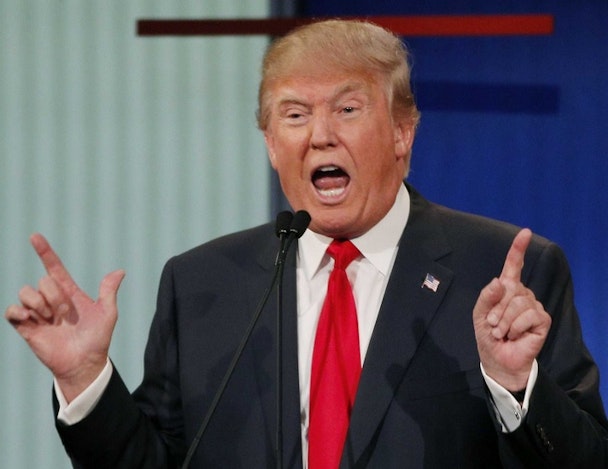Targeting is your Trump card: How the rules of political advertising were rewritten by data
Trump and Brexit represent a seismic shift in politics’ use of data to really take the pulse of the voter and reach them with more relevant messaging. Craig Tuck, RadiumOne's UK managing director, looks at how the process works and the lessons for politics and brand marketers.

Nearly 40 years ago, Saatchi and Saatchi came up with one of the most famous ad campaigns of all time – and the most referenced political campaign ever – which helped propel Margaret Thatcher to power. The iconic Labour Isn’t Working campaign and poster was a classic ‘Mad Men’ example of producing one brilliantly simple idea to achieve cut-through across a population.
Fast forward to last year and a similar seismic shift in how politicians used advertising to get their message across to voters of the day and win. However, the major difference is that the Mad Men with their one-size-fits-all were usurped by the Maths Men who interrogate vast swathes of data to send highly specialised messages to a wide array of much smaller groups of voters. In military terms, it’s going from a medieval catapult to a Royal Marine sniper.
So, what are the key steps to how the process works that can be utilised by both politicians and advertisers.
#1 Strategy comes first
It may sound obvious but it’s a cohesive or coherent strategy that wins elections. For instance, a recurring theme in the post mortem commentaries on the US election is how Trump stayed consistent on his messaging whereas Clinton’s seemed to change more frequently, so it was difficult to get a grip on what she was standing for. Furthermore, Trump’s team focused on just 17 states and then honed in on two 'rust belt' states in the final weeks.
We’ve also seen successful coherent strategies in the past with Tony Blair’s focus on the centre-left message, Barack Obama’s 'Yes We Can' messaging allied to his use of the internet and social media, and campaign director Lynton Crosby’s focus on targeting 100 seats for the Conservative Party. The leave campaign for Brexit did it though targeting everyone outside the media bubble and echo chamber that is London/the south east
#2 Try new methods to understand your consumer
The rise of online and data means there are more ways than ever to measure the pulse of the voter. Those who’ll win voter and consumer minds in the future will harness the new techniques that become available based on (a) how we behave online and (b) companies who can exploit the data produced off the back of it.
The Vote Leave campaign, for example, credited a lot of its success to such a tech company – AggregateIQ – while much has been made of Cambridge Analytica’s role in Trump’s success, particularly its ability in going local and micro to get under the skin of what’s important to their audience and serve appropriate, highly tailored messaging.
A much more simple and accessible new technique is dark social – something that remains scandalously under-employed by politicians and brands. Prior to the 2015 general election, our analysis revealed that 68% of political content shared by people was via dark social channels (email, instant messenger, chat apps and forums – which can’t be measured by standard online analytics tools) – versus just 22% on Facebook and 10% on Twitter. In the run-up to Brexit, dark social accounted for 78%, with Facebook languishing at 10% and Twitter at 8%.
The ‘blanket’ approach of sharing on the social networks is relatively ineffective compared to dark social's power to drum up voter support, as it carries far more emotional weight because it’s normally done on a 1-2-1, implicit, basis with family or close friends. That’s why it’s so surprising more hasn’t been made of it but I don’t expect this situation to last much longer.
#3 The most potent mix is the new and the old
Despite all this, I’m not advocating relegating old methods to the back benches. Cambridge Analytica’s use of psychographics is a prime case in point – the discipline has been around for a while but its clever use of data took it to a stratospheric new level.
Although AggregateIQ’s use of targeted Facebook advertising was cited as a major factor in the Leave vote winning, Clinton’s focus on the same platform was widely heralded as a big mistake – such as targeting 18-24s, those among the least likely to actually go out and vote. Experts have said she ignored print, radio and TV, particularly local, to her detriment – mainly in the key rust belt states – while Trump didn’t. It’s all about having the right system in place to successfully mesh new and heritage media.
Brexit and Trump have opened the eyes of savvy campaigners. Among the many reasons why they won would include a more curious nature about the new opportunities and technology available, allied with a greater willingness to take a risk with them to really understand the pulse of the voter. Thatcher’s famous pronouncement of “this lady’s not for turning” stood her in good stead in 1980 but today it would be political suicide for any campaign team to adopt this mantra when it comes to turning to the brave new world offered by the maths men.
These ideas will be discussed by MediaCom, Maxus and Cambridge Analytica at the Advertising Week Europe session 'Was Hillary ‘Trumped’ by Weak Strategy or Strong Data?'
